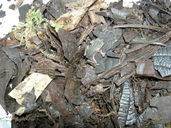|
Description
Male SVL ranges from 22.5 mm to 27.3 mm, while the single female specimen is larger at 33.5 mm. The head is about as broad as long, with canthal, supraorbital, supratympanic, and parietal crests. Skin on top of the head is co-ossified with the underlying cranial bones. In the female specimen the cranial crests are more robust than in the males. The snout is acutely pointed, with protuberant nostrils directed laterally. The distinct canthus rostralis forms a well-developed canthal crest with a concave loreal region. The lip is indistinct. A distinct "V" shaped notch is present at the mandibular symphysis. The tympanum is not externally evident, although a well-developed supratympanic crest is present. Triangular parotoid glands are barely evident. Body shape is robust. Dorsal skin texture appears roughened with numerous distinctly raised, rounded or pointed tubercles, though skin on mid-dorsum is nearly smooth with tubercles more widely scattered. Lateral surfaces of the body and dorsal surfaces of the limbs and flanks are also scattered with small sharply pointed tubercles. The scapular area has fewer tubercles and appears smoother in texture than adjacent areas. Lateral rows of tubercles are distinctly larger and more sharply pointed than nearby tubercles. The skin of the ventral body and limbs is mildly granular with distinctly raised, small, round scattered tubercles; the throat is more evenly granular. Palms and soles are smooth. The choanae are subcircular, small and widely spaced. This species has a long, ovoid tongue approximately three times as long as wide and 2/3 free posteriorly. The forelimbs are slender and short, with broad hands and broad, short fingers. The relative lengths of the fingers are I = II = IV < III. The fingers are mostly webbed, with the webbing formula I0 - 0II0 - 3III3 - 0IV. Palmar and pollical tubercles are not evident on the hands. The hindlimbs are also slender and short, and lack tarsal folds. The relative lengths of the short, broad toes are I = II < III < V < IV. The inner metatarsal tubercle is not evident, while the outer metatarsal tubercle is distinct, low and ovoid. The toes are mostly webbed, in the pattern I0 - 0II0 - 0III0 - 3III3 - 0IV. Teeth and ostia pharyngea are absent from this species. Males also lack vocal sacs, vocal slits, and nuptial excrescences (Vaughan and Mendelson 2007).
In preservative, all dorsal surfaces of the body and head are pale brown with distinct irregular dark brown markings including a dark brown interorbital bar. The tips of the largest dorsal tubercles are unpigmented. Limbs have alternating cream and brown crossbars. Hands and feet are mostly unpigmented dorsally with a few scattered dark brown spots. The lip surface is distinctly white although a few small brown bars are present. The ventral surfaces of the body are characterized by a dull brown scattered with a few irregular cream markings that become larger and more contiguous peripherally. Pelvic region is dull brown with distinct cream-colored markings. Ventral surfaces of the limbs, hands, and feet are dull brown with cream-colored markings (Vaughan and Mendelson 2007). Distribution and Habitat
Country distribution from AmphibiaWeb's database: Costa Rica
Endemic to Costa Rica. This species inhabits areas near Cascajal (including Los Juncos at elevations of 1,500 m to 1,600 m asl), Cerro Chompipe and Reserva Dantas in the Cordillera Central region of central Costa Rica (Vaughan and Mendelson 2007). Individuals have been found in deep leaf litter areas of primary or mature cloudforest with closed canopy (Vaughan and Calvo 2003). Trends and Threats
This species occurs within two protected areas in Costa Rica: Reserva Dantas in the Districto Los Angeles, Canton San Rafael and Los Juncos, which is part of a Forestry Reserve (Vaughan and Mendelson 2007). Potential future threats include urbanization due to the expansion of the city of San José (Stuart et al. 2008). Relation to Humans
Crepidophryne chompipe produces skin secretions which are capable of inflicting notable irritation to human eyes (Vaughan and Calvo 2003).
References
Stuart, S., Hoffmann, M., Chanson, J., Cox, N., Berridge, R., Ramani, P., Young, B. (eds) (2008). Threatened Amphibians of the World. Lynx Edicions, IUCN, and Conservation International, Barcelona, Spain; Gland, Switzerland; and Arlington, Virginia, USA.
Vaughan, A. and Calvo, W. (2003). ''Geographic distribution: Crepidophryne epiotica.'' Herpetological Review, 34, 257.
Vaughan, A. and Mendelson, J.R. III (2007). ''Taxonomy and ecology of the Central American toads of the genus Crepidophryne (Anura: Bufonidae).'' Copeia, 2007(2), 304-314.
Originally submitted by: Alexis Leigh Krup (first posted 2009-09-15)
Edited by: Kellie Whittaker (2009-10-16)Species Account Citation: AmphibiaWeb 2009 Incilius chompipe <https://amphibiaweb.org/species/6908> University of California, Berkeley, CA, USA. Accessed Jun 1, 2025.
Feedback or comments about this page.
Citation: AmphibiaWeb. 2025. <https://amphibiaweb.org> University of California, Berkeley, CA, USA. Accessed 1 Jun 2025.
AmphibiaWeb's policy on data use.
|




 Map of Life
Map of Life